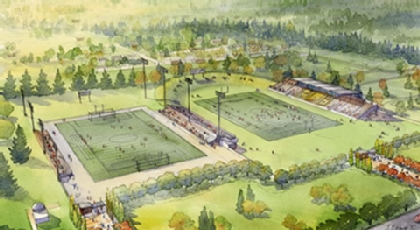Gift for all-purpose field primes athletic facilities transformation
Transforming PLU athletic and recreational facilities took a big step forward recently.
A gift of $1 million for the construction of an all-weather, multipurpose athletic field on lower campus, is making that closer to a reality.

New all-weather, multipurpose athletic field would transform athletic, recreation and wellness opportunities on campus.
The gift from Wilson Construction and the Don and Kim Wilson family pushed total commitments for the $3 million field to more than $2.3 million, as of April 2011.
The Wilson’s firm is a utility contractor based in Canby, Ore., specializing in electrical distribution and transmission power lines. Don and Kim are 1974 and 1976 PLU graduates. Their daughter, Stacy, graduated from PLU in 2003. Daughter Lauren is a University of Oregon graduate.
Don Wilson served on the PLU Board of Regents for nine years in the 1990s and recently rejoined the board.
“PLU gave us a good start toward our careers as successful business people. This gift was a way to recognize the support we received while making a difference for current students,” Don Wilson said.
Avid skiers, Don, Kim and Stacy were members of the ski team while at PLU.
“I didn’t play football, soccer or lacrosse at PLU, but I know that the field will strengthen these programs and general recreation there,” he said. “Athletics is an important part of the university experience and the new field is a good start at a major upgrade of athletic facilities at PLU.”
Depending on the success of further fundraising for the athletic field, site preparation could begin in the fall, leading to the installation of the field in 2012. Construction will be completed in seven to nine months.
The field is the first of two that will serve the, athletic, recreational, physical education and wellness needs of the campus.
It will serve the men’s and women’s soccer programs as a practice and competition field. Football will utilize the field for practice. Club sports, such as Ultimate Frisbee and lacrosse, intramurals, academic activity courses and outdoor recreation will all have the opportunity to use the field.
“The new field will assist in leveling the playing field for athletics and recreation at PLU,” said Laurie Turner, director of athletics. “We are one of a few schools in our conference with no synthetic surfaces on campus.
“Currently, student-athletes in football and soccer often drive off-site to practice. The new field will enable teams to practice, and soccer to compete the entire season on campus. This will eliminate the need to re-schedule games when inclement weather makes our natural grass field unplayable,” Turner said.
Student Life Vice President Laura Majovski said, “The new field demonstrates university support for improving the recreational and athletic facilities on lower campus. That translates into increased interest and support from potential donors, prospective student athletes, current athletes and coaches.
“All students will benefit from the addition of the field.”
For more than a decade, planning for the redevelopment of campus athletic facilities has been carried out by campus master planning groups including faculty, students and staff. Plans have also been subject to community review and comment on multiple occasions. The athletic and recreation projects are part of the long-range Campus Master Plan adopted by the PLU Board of Regents.
In addition to the two fields, plans for future development in the area include a new recreation and fitness center just south of Columbia Center. The area south of that may be a future location for student and multigenerational mixed housing. The area may also include space for passive recreation needs that may include an arboretum.
When construction begins, the PLU University Golf Course will close to make way for the new field. However, it will remain open for most of the 2011 golfing season.
The lower campus transition is part of the university’s comprehensive facilities and grounds long-range development plan, the Campus Master Plan. It sets priorities for renovation, new construction and renewal for the next 15 to 20 years, while supporting intellectual and creative growth of individuals, strengthening the campus community and encouraging stewardship through healthy living, preservation of our history and promoting sustainable practices that encourage efficiency in our use of resources.


